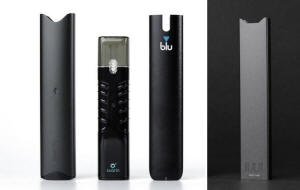|
Special Report: High-nicotine
e-cigarettes flood market despite FDA rule
 Send a link to a friend
Send a link to a friend
 [September 24, 2018]
By Chris Kirkham [September 24, 2018]
By Chris Kirkham
(Reuters) - The sleek Juul electronic
cigarettes have become a phenomenon at U.S. high schools, vexing
educators and drawing regulatory scrutiny over their sweet flavors and
high nicotine content.
Now, a new wave of lower-priced Juul knock-offs is showing up at
convenience stores, vape shops and online - despite a U.S. Food and Drug
Administration rule banning the sale of new e-cigarette products after
August 2016 without regulatory approval.
Start-ups and major tobacco firms have launched more than a dozen new
high-nicotine devices with Juul-like designs since the FDA imposed the
deadline, according to a Reuters review of the companies’ online
advertisements, social media posts and public statements.
The FDA earlier this month threatened to ban Juul and four other leading
vaping products unless their makers take steps to prevent use by minors.
But the warning came after companies introduced a slew of new Juul
copycats following the August 2016 deadline with no regulatory
consequences.
In a statement to Reuters, the agency said it was investigating whether
certain brands are being improperly sold without FDA approval and that
it “plans to take additional action on this front very soon.” The agency
said it would focus on products with high-nicotine concentrations and
flavors appearing to target young people, and take “swift action
wherever appropriate.”
The FDA set the August 2016 deadline to rein in the fast-growing
industry but allowed sales of Juul and other older devices to continue
without regulatory approval until 2022.

The companies that started marketing new devices after the deadline
include startup firms such as Kandypens, Myle Vapor and VGOD, as well as
large multinational tobacco companies including British American Tobacco
Plc and Imperial Brands Plc.
Kandypens touted its new Rubi vaping device last October - more than 14
months after the August 2016 cutoff - with an Instagram post saying it
had been “working hard over here for the last 12 months” on the product.
Vaping distributor VGOD posted on its website in May that it was “an
honor to finally introduce the STIG,” referencing its Stig Pods, a
disposable three-pack of high-nicotine devices.
British American Tobacco chief executive Nicandro Durante said on a July
2018 earnings call that the company would be launching its
higher-nicotine Vuse Alto product in the United States the following
month. Imperial Brands announced its myblu brand of e-cigarettes in a
February 2018 press release.
Kandypens, Myle and VGOD did not respond to requests for comment.
Spokespeople for Imperial Brands and British American Tobacco said their
products were compliant and on the market before August 2016. Imperial
Brands said it had purchased an existing e-cigarette brand and renamed
it. British American Tobacco did not respond to questions about its
marketing or sales.
A spokeswoman for Juul Labs Inc, Victoria Davis, said the company is
cooperating with regulators and working to prevent underage use of a
product designed to help adult smokers quit tobacco cigarettes.
“No minor or non-nicotine user should ever try Juul,” Davis said.
E-cigarettes vaporize a liquid that contains nicotine, the addictive
stimulant that gives smokers a rush. The Juul design mimics a flash
drive - with plug-in cartridges of concentrated nicotine juice. It is
far more compact than earlier vaping devices and produces less vapor,
making it easy to use without being detected - an attribute some health
advocates say attracts teenagers.
Juul’s imitators are also small and compatible with higher-nicotine
blends, though some can also be filled with lower-strength juice.
The Chinese company Suorin introduced several such devices to the United
States over the past year. Many high-schoolers and college students said
they have switched to these products because buying widely available
nicotine liquids is less expensive than Juul pods.
In a statement, Suorin said it didn’t have “clear guidance” from the FDA
on regulations governing its newer products but hopes to better
understand how to fully comply. The company said its products are only
intended for adult smokers.
One Juul pod has the nicotine content of about 20 cigarettes – the
number in a traditional pack – according to Juul’s marketing. A pod can
be consumed in a day by a heavy user, according to interviews with Juul
customers.
Many of the newest blends from Juul and its imitators - called “nicotine
salts” in the industry - contain a compound called benzoic acid, which
lowers the pH level of the liquid. That reduction allows users to take
in more nicotine without a bitter taste, according to the U.S. Centers
for Disease Control and Prevention (CDC).
In addition to the devices, dozens of high-nicotine e-liquids have
arrived on the market with names such as “frozen mystery pop,” “rainbow
drops” and “Tokyo chocolate banana,” which critics say are designed to
attract young customers.
Vaping proponents argue the Juul and similar new products give cigarette
smokers looking to quit a much better option than lower-nicotine
e-cigarettes.
“It gives the same exact sensation as a cigarette, except you don’t wake
up coughing at 2 a.m.,” said Charles Trejo, a manager at V for Vape, a
Los Angeles retailer.
Public health researchers say high-nicotine vaping devices like the Juul
have proven adept at drawing in new customers, including teenagers, who
never used tobacco.
“What they’re doing is creating addicts in large numbers,” said Dr.
Robert Jackler, a professor who heads a group studying the impact of
tobacco advertising at Stanford University.
High-nicotine vaping devices amount to a “weaponization” of the drug, he
said, citing research showing young people are particularly susceptible
to nicotine addiction, which could lead them to other addictions
including cigarettes.
HIGH SCHOOL 'JUUL ROOMS'
The companies launched the copycat devices as Juul’s market share surged
from 13.6 percent of the e-cigarette market in early 2017 to more than
70 percent now, according to a Wells Fargo analysis of Nielsen retail
data, which does not include online sales.
The FDA’s regulation of e-cigarettes has come under scrutiny in recent
months as Juul’s popularity has taken off. Anti-smoking advocates
complained about the Juul lookalikes in an August letter to the FDA,
saying the agency had failed to assert its authority over companies that
had “evaded the review process.” The FDA said it planned to respond to
the letter but declined further comment.
Vaping increased by nearly eightfold between 2011 and 2017 among U.S.
high school students, according to the most recent CDC data. Experts say
last year’s survey likely underestimates the increase because it was
conducted before a surge in Juul sales.
[to top of second column]
|

An electronic cigarette device made by JUUL (R) is shown next to
other similar devices (L to R) Vuse Alto, Suorin ishare and myblu in
this photo illustration taken September 20, 2018. Picture taken
September 20, 2018. REUTERS/Mike Blake/Illustration

Many high schools have resorted to locking bathrooms – jokingly
called “Juul rooms” by students. Marcella Bianco, who helps develop
school anti-vaping curriculum for the non-profit organization Catch
My Breath, said elementary schools have recently started requesting
materials.
Educators fear the high-nicotine devices could erode decades of
progress in reducing youth tobacco use. Smoking among high school
students declined from 15.8 percent to 7.6 percent between 2011 and
2017, according to the CDC, but e-cigarette use grew from 1.5
percent to 11.7 percent over the same period.
“It’s like a flashback to 20 years ago,” said Kathryn Hensley, a
school board member in St. Lucie County, Fla. “Are we starting all
over again?”
E-cigarettes have occupied a regulatory gray area in the United
States since they emerged a decade ago. Only in 2016 did the FDA
finalize rules to regulate e-cigarettes, including the requirement
that companies get approval for new products.
Research on the long-term health effects of e-cigarettes is limited.
They are widely viewed as safer than tobacco cigarettes because they
don’t contain the same cocktail of toxic and cancer-causing
chemicals.
The U.K. Royal College of Physicians said in a 2016 report that
e-cigarettes were 95 percent less harmful than smoking tobacco,
citing a reduction in the risk of serious disease and death. The CDC
has said e-cigarettes are safer than conventional cigarettes but has
not assigned a specific risk reduction because the products can vary
widely.
Some health experts are particularly worried about the impact of
nicotine from e-cigarettes on adolescents. Research from a 2016 U.S.
Surgeon General’s report found that such exposure could have
“lasting adverse consequences for brain development and cognition”
on teenagers. A study released by the National Academy of Sciences
this year cited evidence that vaping among young people increases
the risk of eventually smoking tobacco.
BANNED IN OTHER COUNTRIES
High-nicotine vaping devices and liquids are not allowed in many
other parts of the world, including in the European Union and the
United Kingdom, which have both set nicotine limits at 20 mg/mL in
e-cigarette liquids. Regulators said that level was effective for
most smokers trying to quit.

Juul pods are rated at 59 mg/mL, according to the company’s
marketing. Israeli regulators last month banned Juul out of concern
over its high nicotine content, saying the device “posed serious
danger to public health.”
Davis, the Juul Labs spokeswoman, said in August the company was
“incredibly disappointed” with what it called the Israeli
government’s “misguided decision” to crack down on healthier
alternatives to tobacco cigarettes.
Imperial Brands’ new myblu product arrived in the United States
earlier this year. Matt Kessler, a spokesman for Fontem Ventures,
the Imperial Brands unit that owns myblu, said the brand complies
with the FDA rules because it is a re-imagination of a similar
e-cigarette that was marketed by a company that Imperial brands
acquired a year earlier.
The new myblu brand, however, offers 4 percent nicotine strength,
meaning at least 40 mg/mL, according to company advertising, higher
than any previously offered by the earlier e-cigarette model, called
My Von Erl.
Devices that vaporize higher-nicotine liquids fall under the
definition of new products subject to FDA review, according to the
2016 regulation. Kessler declined to comment further on nicotine
levels in myblu, saying only that the product “is compliant with FDA
regulations.”
Durante, the CEO of British American Tobacco, acknowledged on the
July earnings call that its Vuse Alto device had not been widely
available before the August 2016 deadline. He said that’s not
required under FDA rules.
“To be grandfathered” by the FDA, he said, “you could be in market,
in one store, two stores only in the whole country.”
The FDA declined to comment on whether myblu and Vuse Alto are
compliant or if availability in one or two stores would be
considered “on the market.” The agency said it would consider “the
totality of the evidence” to decide a whether a vaping product had
been commercially available before the regulatory deadline.
STRUGGLE TO QUIT
As new high-nicotine Juul competitors arrive, vaping enthusiasts on
YouTube are posting reviews of the next “Juul killer” aiming to take
a piece of the red-hot market.
Milo Gringlas, a freshman at Cornell University, said Juul has
become so ubiquitous on campus that a popular late-night food truck
now sells vaping devices and nicotine liquids.
“Everybody either has one or is looking for one,” he said.
Austin Tompkins, who lives in Los Angeles, has struggled for the
last six months to kick his addiction to Juul, which he started
using about three years ago, when he was 19. He realized he needed
to stop when he would wake up in the middle of the night needing
another hit.
In his latest attempt, he’s made it two months without vaping. The
urge hasn’t gone away.
“I’m telling you, right now, I would love a hit of a Juul,” he said.
(Reporting by Chris Kirkham; Editing by Vanessa O'Connell and Brian
Thevenot)
[© 2018 Thomson Reuters. All rights
reserved.]
Copyright 2018 Reuters. All rights reserved. This material may not be published,
broadcast, rewritten or redistributed.
Thompson Reuters is solely responsible for this content. |